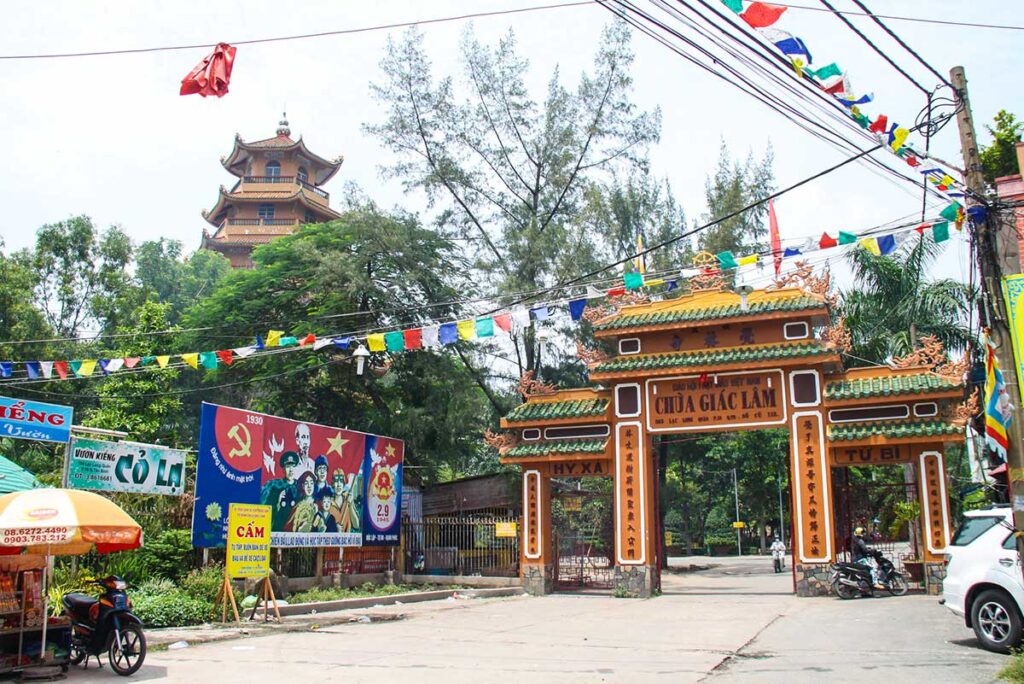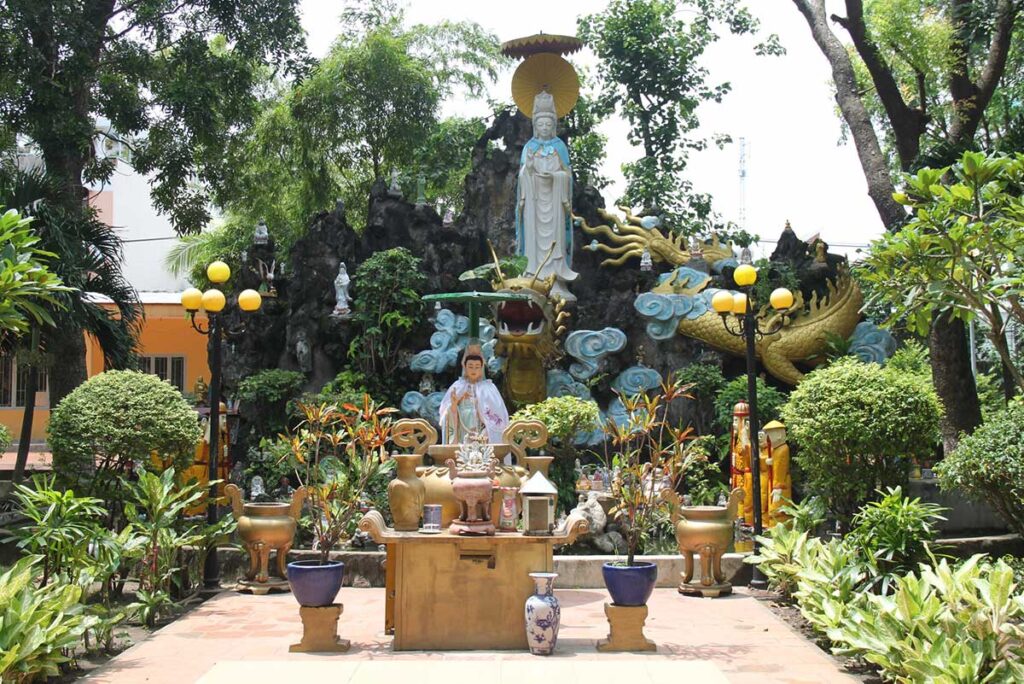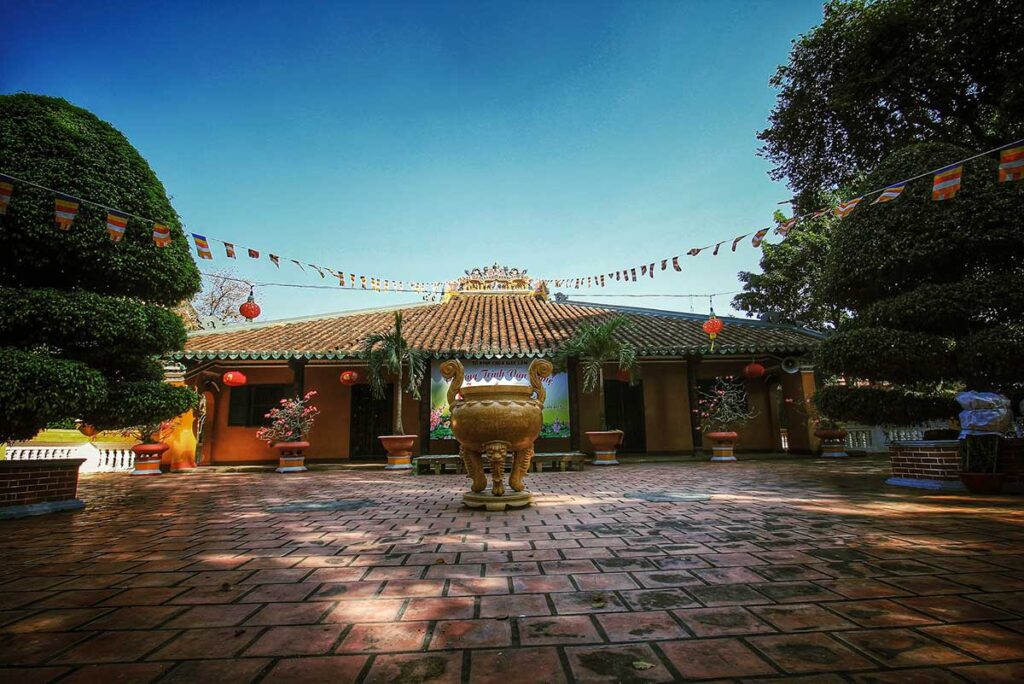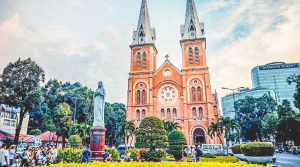Giac Lam Pagoda, located in Ho Chi Minh City, is a fascinating religious complex that carries a rich history of nearly 300 years. It is located quite a bit from the city center, so visiting this pagoda offers a unique opportunity to experience a more local and traditional side of the city.
Visiting information
- Address: 565 Lac Long Quan Street, Ward 10, Tan Binh District, Ho Chi Minh City.
- Opening times: Daily from 6:00 AM to 9:00 PM.
- Entrance fee: Free of charge.
Giac Lam Pagoda is located west of the city, approximately 7 km from the city center (District 1). The easiest way to reach the site from central Ho Chi Minh City or Cholon is by taxi or motorbike taxi, which takes around 20-30 minutes depending on traffic conditions. The taxi fare from Ho Chi Minh Airport to Giac Lam Pagoda is approximately 150,000-200,000 VND ($6-9 USD). Alternatively, you can use taxi apps for convenience.
Another option is to take bus route number 27 from the bus station at Ben Thanh, which is the cheapest way to get there.
Tips & rules for visiting
- Dress dode: Ensure that you dress appropriately by covering your shoulders and knees.
- Respectful behavior: While filming and photography are not prohibited, it is important to behave delicately in spiritual places. Make sure that your camera or video recording device is silent and without flashes. Avoid taking photos of monks, other Buddhist groups, or visitors without obtaining permission.
- Explore the local side: Keep in mind that there aren’t many other tourist sights in the immediate vicinity of Giac Lam Pagoda. However, visiting the pagoda offers a unique opportunity to experience the local side of the city and immerse yourself in its cultural heritage.
- Festivals and special occasions: Giac Lam Pagoda attracts many people during special occasions like the Tet holiday and the Vesak. These are times when people come to pray to the Buddha and bring offerings to the deities. Additionally, the pagoda holds various festivals during the 1st Full Moon and the Vu Lan festival.
- Explore other temples: If you’re interested in seeing more of these places, you can check out our list of the best temples in Ho Chi Minh City for additional recommendations and insights.
History of Giac Lam Pagoda
Giac Lam Pagoda, one of the oldest pagodas in Ho Chi Minh City, holds a rich history that spans nearly 300 years. It was constructed in 1744 by a Chinese monk named Ly Thuy Long. Originally named Cam Son, it was situated on Cam Son Hill. However, it was later renamed Giac Lam when Vien Quang became the new abbot over 30 years later. Since then, the pagoda has served as an important center for teaching Buddhist commandments to monks in Southern Vietnam and preserving and copying significant Buddhist scriptures.
Throughout its history, Giac Lam Pagoda has been meticulously maintained by various abbots and has undergone several renovations, particularly under the guardianship of Thich Vien Quang and Thich Hong Hung in the 18th and 19th centuries.
Today, the pagoda stands as one of the oldest and most revered pagodas in Ho Chi Minh City, characterized by its solid architecture and profound religious significance. It continues to be a place of spiritual practice and preservation of Buddhist teachings for both monks and visitors alike.
Architectural highlights of the pagoda complex
Giac Lam Pagoda is one of the oldest and most beautiful temples in Ho Chi Minh City that showcases a harmonious blend of traditional Asian elements.

To enter the pagoda, you will pass through a triple gate built in 1955, each adorned with intricately designed roofs.


Once inside, you will be greeted by the front garden, where a remarkable Bodhi tree, gifted to Vietnam by a Sri Lankan Buddhist monk in 1953, stands. The tranquil atmosphere is enhanced by statues and a grave nestled in the open garden, where you may encounter locals taking peaceful walks.

The pagoda itself is characterized by a rectangular-shaped building, incorporating three smaller structures: the main ceremonial hall, altars of patriarchs, and dining hall, all designed in traditional Vietnamese architecture. Supported by 98 meticulously carved pillars bearing Buddhist couplets, the pagoda houses a collection of antiques and over 100 statues, some made of bronze and others of wood, within the altars of patriarchs.

The main hall features steep roof tiles designed for effective rain drainage, and its entrance arch is embellished with artistic crockery plates showcasing the pottery customs of the Southern region. Inside, sacred altars hold reverence for Amitabha Buddha, Sakyamuni Buddha, and four bodhisattvas: Samantabhadra, Manjushri, Avalokiteshvara, and Mahasthamaprapta. Along the passages, you’ll find statues of the 18 Arhats and the 10 kings of hell, among the oldest statues in the pagoda.

A notable feature of the pagoda complex is the multi-story stupa. Standing 32 meters high, the stupa has seven floors, each hexagonal in shape. It serves as a repository for relics of Gautama Buddha, brought alongside the Bodhi tree by the monk Narada many years ago.
As you ascend the stupa, you will encounter numerous ancient Buddhist relics on display. A statue of Bodhisattva stands at the entrance. Originally designed by architect Vinh Hoang in 1970, the construction was suspended in 1975 and completed in 1994, making it a prominent landmark in Ho Chi Minh City.
Adjacent to the main building, you will find a complex of abbots’ stupas. Among them, the stupa dedicated to the respected monk Thich Vien Quang holds particular significance. Most of the stupas have three to four floors, and one special square statue symbolizes the four immeasurables: love, compassion, empathetic joy, and equanimity (tu, bi, hi, xa).








